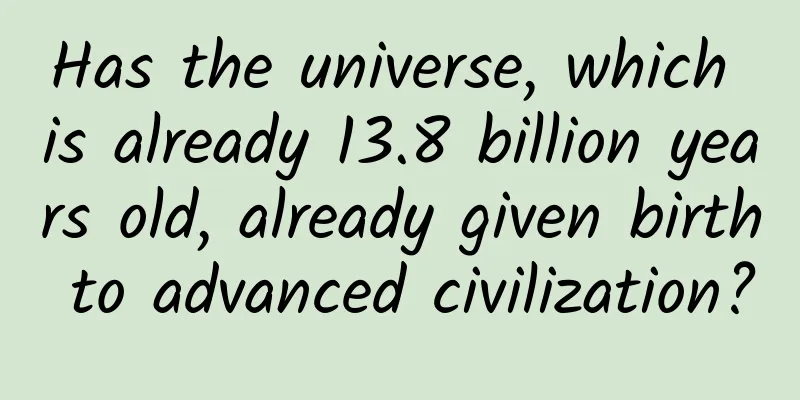Has the universe, which is already 13.8 billion years old, already given birth to advanced civilization?

|
This article is based on an answer to a question invited by netizens: The universe is 14 billion years old. How many civilizations have existed and disappeared? Why has no civilization evolved to the point where it can travel through the stars and find us through wormholes? At present, the scientific community has not yet reached a unified and accurate understanding of the age of the universe. According to the different Hubble constants measured by different scientific teams, the age of the universe is between 11.4 billion and 15 billion years old. The scientific community generally adopts 13.82 billion years. I have answered many questions about extraterrestrial civilizations, but many people are still very interested and keep asking questions like these. I will talk about them again and discuss and share them with netizens. Are there other civilizations in the universe besides Earth? The current scientific understanding of the universe is that the universe is divided into observable universe and unobservable universe. The observable universe has a radius of about 46.5 billion light years and contains trillions to 10 trillion galaxies. Our sun is just one of the 400 billion stars in the Milky Way, and the earth is just one of the eight planets in the solar system, with a mass of only 1/330,000 of that of the sun. What does this mean? The Earth is like a speck of dust in the Milky Way, and has no sense of existence in the universe. Therefore, many scientists believe that in the vast universe, it is impossible that the Earth is the only one that gave birth to life and civilization. There are many civilizations in the universe, but the universe is too vast and it is difficult for civilizations to meet. In the last century, American astronomer Frank Drake proposed a formula to estimate the number of civilizations in the Milky Way, which is called the Drake equation. However, there are several key data in this equation that are difficult to determine, such as the time that technological civilization can exist. These data determine the number of civilizations that may exist at the same time. Many scientists have calculated the number of possible civilizations in the Milky Way based on this equation, and the results obtained are very different. It is generally believed that the number of civilizations in the Milky Way is at least 1, the total number is 100,000, and the maximum number is 1 million. So since there is at least one civilization in at least one galaxy, and there are at least 1 trillion galaxies in the observable universe, which means there are at least 1 trillion civilizations, why can't we know each other and meet each other, or why haven't advanced civilizations traveled through wormholes to find us? First, the distance between civilizations is too great. Let's do some calculations: the Milky Way has a diameter of about 200,000 light years, a thickness of about 10,000 light years, and a volume of about 314 trillion light years. If the Milky Way has a maximum of 1 million civilizations, the average distance between these civilizations is 680 light years; if there are only 100,000 civilizations, the average distance between them is 1,465 light years. What is the concept of a light year? It is the distance that light travels at a speed of about 300,000 kilometers per second for one year, which is about 9.46 trillion kilometers. The speed of light is the fastest speed in the universe, and electromagnetic waves are energy transfer mediated by photons, so they are also the speed of light. This means that if there are 1 million civilizations in the Milky Way, it will take 1,360 years for a round trip using radio waves; if there are 100,000 civilizations, it will take 2,930 years for a round trip using radio waves; and if there is only one civilization in a galaxy? A round trip using radio waves will take at least hundreds of thousands or even millions of light years. How long is the history of mankind? We only know the principles of eating, drinking, defecating and urinating, and there are only a few thousand years of written records; the history of elementary science is only a few hundred years, and the history of modern science such as radio is only more than a hundred years. Therefore, we have been sending messages to aliens since the invention of radio, but we have not yet reached an alien station. What if we are the only civilization in the entire Milky Way? Then we have to look for like-minded people in other galaxies. The nearest galaxy, the Large Magellanic Cloud, is a satellite galaxy of the Milky Way. It is very small, with a mass of only about 1/40 of the Milky Way, and is 165,000 light-years away from us. If it is difficult for such a small galaxy to give birth to civilization, the nearest medium-sized galaxy to us is the Andromeda Galaxy, which is 2.54 million light-years away. This means that if a telegram was sent when humans were still apes, it would only be received now. This shows that even if civilizations are universal, it is difficult to know each other at the speed of light, let alone meet each other. Any civilization will face numerous natural and man-made disasters in the process of growth, especially in the early stages of civilization. If a civilization encounters a huge natural disaster, it will be extinct. Scientists believe that the gamma-ray bursts in the universe alone regularly or irregularly eliminate more than 90% of life and civilization in the universe. Therefore, the probability of civilization developing to a high level in the cracks of survival is extremely small. This is also the Drake equation about how long technological civilization will last, which determines the probability that civilizations in the universe can communicate. A brief history of mankind's search for extraterrestrial civilizations: On February 14, 1990, Voyager 1 flew to a distance of 6.4 billion kilometers from the earth, glanced back, and took a stunning photo. In the photo, the earth was only a dim light spot that seemed to be there and not there. The "dust" here is only 0.12 pixels, but it supports more than 7 billion people and countless lives. On Earth itself, all living things are bustling around, and we don't feel lonely at all. But the "worrying" scientists feel differently. They are always asking the heavens: In the vast universe, is human civilization the only one left? If so, it would be too lonely. Before the invention of radio, astronomers observed the starry sky through telescopes, hoping to find some clues about the existence of extraterrestrial civilizations, but they were disappointed every time. From time to time, there would be some rumors of UFO or alien sightings in society, but so far, there has not been a single case with scientific evidence to confirm it. Not long ago, the US government released several UFO videos, but no substantial findings have been made. UFO is not an alien flying saucer, but an abbreviation of Unidentified Flying Object. UFO is just "unknown". It may be a natural phenomenon, a man-made object, or a light or illusion. Radio telescopes appeared in the last century, which are used to understand the universe by scanning, detecting and receiving space radio waves. On November 16, 1974, scientists used the Arecibo radio telescope, the most powerful in the world at that time, located in Puerto Rico, to send a powerful signal into space. This transmission was called "the first letter sent to aliens." This telegram is flying towards the M13 star cluster in Hercules, 25,000 light-years away from us. There are millions of stars there. As long as there is a civilization among them that can decipher human telegrams, these aliens will know of our existence. The letter was encoded in binary. It took less than 3 minutes to send the entire letter. The decoded letter contained 1,679 characters, forming a rectangular array of 73 rows and 23 columns. When the aliens received and decoded the letter, they would get the following information: From the fact that the number of rows and columns of the code are both prime numbers, we can know that this is not a natural signal, but an intelligent signal; the position of the sun in the Milky Way and the position of the earth in the solar system; the shape and basic structure of human gene DNA; the appearance of the Arecibo radio telescope, etc. See the figure below: Now this letter has traveled in space at the speed of light for 48 years, which is still a very short distance compared to 25,000 light years. Humans will have to wait 50,000 years to receive a reply from aliens. What will humans look like by then? Will they still exist, or have they already migrated out of the earth? Scientists have also taken many measures to establish contact with aliens, such as the Pioneer 10 and 11 unmanned probes, Voyager 1 and 2 unmanned probes launched in the last century, which carry a variety of information about the Earth and humans, including Earth coordinates, languages and songs of people all over the world, etc. These probes have already completed their solar system exploration missions and are flying outside the solar system. But these spacecrafts are too small and fly too slowly compared to the vast universe. The fastest and farthest spacecraft, Voyager 1, flew at 17 kilometers per second for 45 years to cover a distance of 23.3 billion kilometers. It will take more than 17,000 years to fly out of the gravitational range of the solar system with a radius of 1 light year. Proxima Centauri is the nearest star to us, 4.22 light years away. Voyager 1 is flying in that direction, and it will take more than 70,000 years to fly past Proxima Centauri. Therefore, with the current technological capabilities of human beings, we are completely incapable of communicating with aliens. If there are advanced civilizations in the universe, why haven't they come to us? Science is about evidence, and there is no evidence to prove that there are extraterrestrial civilizations in the universe, let alone advanced civilizations. But the universe is already 13.8 billion years old. We assume that the universe has long nurtured advanced civilizations that can cross interstellar space, so why haven't they come to us? Let’s take a brief look at the levels of cosmic civilization. This is just a scientific conjecture about cosmic civilization, which was proposed by Soviet scientist Kardashev in the 1960s. His theory divides cosmic civilization into three levels, namely: first-class civilization can only control its own mother star, which is the Earth for us; second-class civilization can control its own mother star, which is the Sun and the solar system for us; third-class civilization can control its own galaxy, which is the Milky Way for us. The level of civilization is measured by the energy consumed by interstellar communication. According to the current energy consumption of human beings, the level of civilization has only reached level 0.73. To conduct interstellar communication, at least level 2 civilization must be achieved; to conduct intergalactic communication, it must reach level 3 civilization or above. Some scientists believe that it will take another 200 years for human civilization to reach level one; 5,000 years to reach level two; and it is unknown how long it will take to reach level three, a god-level civilization, perhaps hundreds of millions or even billions of years. If there are level-two extraterrestrial civilizations in the Milky Way, they can only operate near their own stars. Even if there are 1 million civilizations in the Milky Way and they all reach level-two, the nearest one would be 680 light-years away from us. Higher-level civilizations must be extremely rare, and the distance would be at least tens of thousands of light-years. Therefore, it is very difficult to achieve communication and interaction between civilizations. The more important question is, even if there are advanced civilizations in the universe, what use do they have to find us? Advanced civilizations are completely different from low-level civilizations like ours. Some people describe it as the gap between humans and cockroaches or ants. If that is true, why would advanced civilizations look for us? Moreover, it is much more difficult for a civilization to find another civilization in the universe than to find a needle in a haystack. Would you spend the energy of the entire country or even the world to salvage a needle? And even if you exhaust all your efforts, you may still not be able to find it. Advanced civilizations may not care about the Earth. In addition, once a civilization develops to a high level, the civilization body (such as humans) is no longer in human form. Humans are now beginning to study the transfer of consciousness, and in the future they will definitely achieve immortality in the form of consciousness. Therefore, when they reach a high level of civilization, their material needs and ideology will undergo fundamental changes. In this case, why do they look for humans? There are often people who mysteriously call for: once aliens discover the earth, they will come to invade and plunder, so we must not expose ourselves, and even if aliens call us, we should not answer. There are many scientists among these people, such as Hawking. But he also launched science fiction projects such as "Breakthrough Listen" and "Breakthrough Starshot", both of which are huge investments and modern scientific methods to find aliens. I don't understand his contradictory actions. I have always scoffed at the idea of "don't talk to aliens", even if it was said by Hawking. This is completely ignorant of the future direction of civilization. There are countless planets in the universe with countless environments, so the breeding of extraterrestrial civilization must be completely different from that of the Earth. Some resources on Earth may not meet the needs of aliens. What are they going to steal? The so-called earth resources are nothing more than air, water, sunlight and temperature. Water is very common in the solar system. There are at least 10 planets with large amounts of water. Among these 10 planets, the earth can only be ranked third from the bottom. Each planet has a completely different atmosphere. Sunlight is available to every star. Who needs it? Moreover, for civilizations born in different environments, the resources of the Earth are likely to be strong poisons to them, and they will die if they are touched. For example, some scientists believe that there may be life on Titan, which feeds on methane, breathes nitrogen, and grows at about -180℃. If they come to Earth, the temperature alone will evaporate them, not to mention water and oxygen. Therefore, those who are afraid of aliens coming to rob are overthinking. The only thing that a high-level civilization needs is energy, and the most abundant thing in the universe is energy. Star energy is inexhaustible. But when civilization develops to a certain level, with energy, it can create everything. Including the oxygen, water, and soil of the earth can be easily created, and creating life is a piece of cake. Why would they go to such a remote place as the earth to rob? As for wormhole travel, it is still only a theory and conjecture, a prediction made by Einstein based on the theory of general relativity. Whether we can really find wormholes in the future, or use them for time travel, is still unknown. According to the reasons I mentioned above, even if we can travel through several light years in an instant, it is not easy to find the earth in a certain direction, and they are not interested in chatting with a cockroach. What do you think about this? Welcome to discuss, thank you for reading. The copyright of Space-Time Communication is original. Infringement and plagiarism are unethical behavior. Please understand and cooperate. |
<<: If a child doesn’t grow tall, can a shot of injection fix it?
>>: Before drawing a book worth 76.23 million, he... went bankrupt first?
Recommend
What are the daily work contents of bidding and the daily work flow of Baidu bidding specialists?
For many friends who have just started SEM, they ...
Sleeping is the same as not sleeping! "Fragmented sleep" has become a hot topic! What should I do?
How's your sleep? In recent days, there have ...
What can UCloud do to accelerate Chinese companies’ overseas expansion?
The original intention of globalization strategy ...
This kind of food is recommended by the whole network in summer, but I advise you not to eat it
Summer is here, and it is a great season to eat r...
Will sitting on a hot bench that someone else has sat on cause hemorrhoids, boils, or even STDs? Let's clarify once and for all →
During the morning and evening rush hours, when y...
APP operation: How to design an activity that users can’t stop
520 has just passed and the Dragon Boat Festival ...
How to build a B2B marketing omni-channel system?
Improving the conversion rate from leads to wins ...
After school starts, two diseases are prevalent, parents must pay attention →
After the spring semester begins, hand, foot and ...
Video advertising tips for the K12 education industry!
In the past two years, vertical screen short vide...
How can such a low-level product advertising creativity generate sales of over 100 million?
The product advertisement I share with you today ...
Back to school season, these safety tips should be kept in mind! - Traffic
The new semester is about to begin. Children on t...
Do cockroaches no longer like sweets?
When you pick up the dirty laundry basket in the ...
Why doesn’t milk taste as good as it used to?
In addition to the humanistic factor that "m...
Top search! Mexico exhibits "alien remains", becoming the "first country to admit the existence of aliens"?
In the past two days, a hot search about aliens h...









